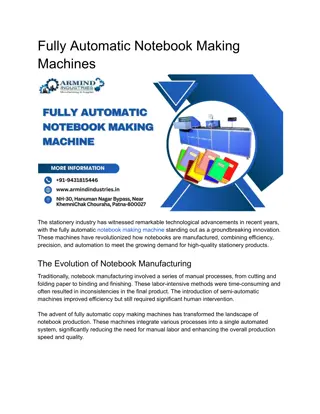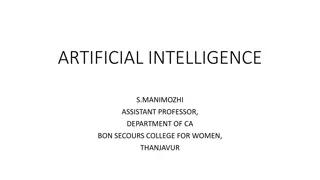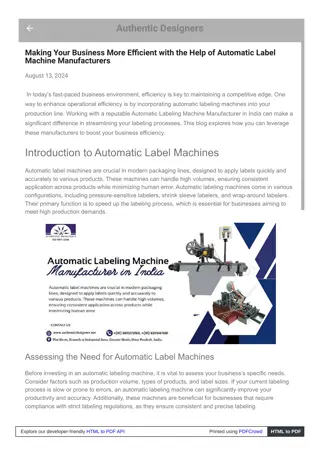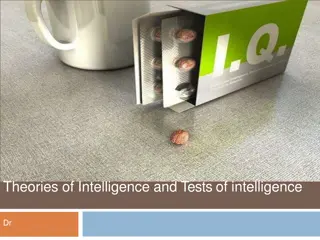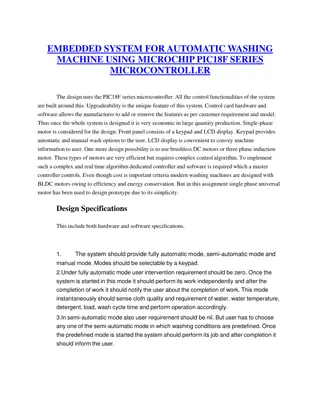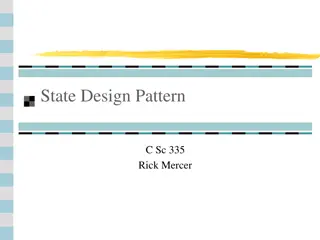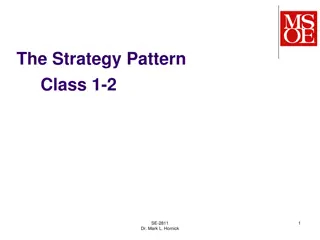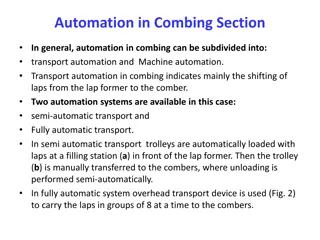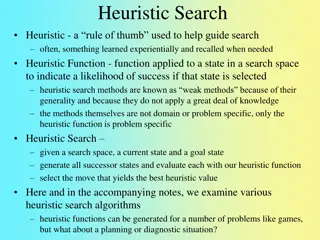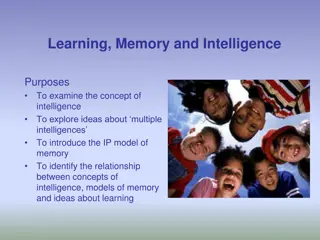Multi-Heuristic Machine Intelligence for Automatic Test Pattern Generation
The 31st Microelectronics Design and Test Symposium featured a virtual event discussing the implementation of multi-heuristic machine intelligence for automatic test pattern generation. The presentation covered motivation, modus operandi, experimental results, conclusions, and future works in the field. Emphasizing the use of machine intelligence, particularly supervised, unsupervised, and reinforced learning methods, the session highlighted how Principal Component Analysis (PCA) can enhance random pattern test generation by filtering faults and guiding backtracing processes.
Download Presentation

Please find below an Image/Link to download the presentation.
The content on the website is provided AS IS for your information and personal use only. It may not be sold, licensed, or shared on other websites without obtaining consent from the author. Download presentation by click this link. If you encounter any issues during the download, it is possible that the publisher has removed the file from their server.
E N D
Presentation Transcript
31stMicroelectronics Design and Test Symposium 22 Virtual Event Multi-Heuristic Machine Intelligence Guidance in Automatic Test Pattern Generation Soham Roy (Speaker), Spencer K. Millican, Vishwani D. Agrawal Dept. of ECE, Auburn University, Auburn, AL 36849 May 26, 20222
Outline Outline Motivation Modus Operandi Experimental results Conclusions Future Works
Motivation Motivation | | ATPG - An example ATPG Search for an input vector to detect a given fault. Complexity increases exponentially with circuit size. 0 1 1 1 0 X 1 0 X D 1 D Test found! 1 1
Motivation Motivation | | ATPG- Backtraces and backtracks Goal = 1 Failure! Backtrack Goal = 1 Success! 0 1 0 1 1 0 1 1 1 Failed (undone) backtrace points Two successful backtraces resulting in goal met Unsuccessful backtrace resulting in backtrack
Modus Operandi Modus Operandi - - Random Pattern Test Generation (RTPG) Set Input Probabilities Generate Random Vector Change Probabilities Continue Simulate Faults Check Coverage Stop (Adequate Coverage or Random Vectors Ineffective)
Modus Operandi Modus Operandi - - Machine intelligence (MI) Supervised learning Solver Desired outputs Trainer Input problems Unsupervised learning Trainer Evaluator Reinforced learning Principal Component Analysis (PCA) S. Roy, S. K. Millican, and V. D. Agrawal, Unsupervised Learning in test Generation for Digital Integrated Circuits, in Proceedings of the European Test Symposium, Belgium (Virtual Event), Feb. 2021.
Modus Operandi Modus Operandi - - Principal Component Analysis (PCA)
Modus Operandi Modus Operandi - - PCA applied to RTPG filtered faults Features: Distance, COP, SCOAP Database containing circuit line s information based on features PCA-guided backtracing PCA CPU time, backtracks, & backtraces COP-guided backtracing ATPG Distance-guided backtracing SCOAP-guided backtracing
Modus Operandi Modus Operandi Principal Component Analysis (PCA) for backtracing Objective value at output of a gate based on SCOAP SC0 [3] 0 Objective value at output of a gate based on SCOAP SC1 [3] 0 Objective value at output of a gate based on Distance [1] Objective value at output of a gate based on COP [2] Objective value at output of a gate based on PCA Gate Type Value 0 1 0 1 1 1 0 1 AND Min Max Min Min Min Min Max Max ? ? NAND Max Min Min Min Min Min Max Max ? ? OR Max Min Max Max Max Max Min Min ? ? NOR Min Max Max Max Max Max Min Min ? ? Objective value at output of a gate based on SCOAP SC0 [3] 0 Objective value at output of a gate based on SCOAP SC1 [3] 0 Objective value at output of a gate based on Distance [1] Objective value at output of a gate based on COP [2] Objective value at output of a gate based on PCA Gate Type Value 0 1 0 1 1 1 0 1 AND Min Max Min Max Min Max Min Max Min Max NAND Max Min Max Min Max Min Max Min Max Min OR Max Min Max Min Max Min Max Min Max Min NOR Min Max Min Max Min Max Min Max Min Max 1. 2. 3. P. Goel, An Implicit Enumeration Algorithm to Generate Tests for Combinational Logic Circuits, IEEE Transactions on Computers, vol. C-30, pp. 215 222, 1981. F. Brglez, On Testability Analysis of Combinational Circuits, Proc. International Symp. Circuits and Systems, pp. 221 225, 1984. L. Goldstein, Controllability/Observability Analysis of Digital Circuits, IEEE Transactions on Circuits and Systems, vol. 26, pp. 685 693, 1979.
Modus Operandi Modus Operandi Principal Component Analysis (PCA) for D-drive D-drive selection criterion w.r.t heuristics Distance COP SCOAP PCA Min Max Min Min 1. 2. 3. P. Goel, An Implicit Enumeration Algorithm to Generate Tests for Combinational Logic Circuits, IEEE Transactions on Computers, vol. C-30, pp. 215 222, 1981. F. Brglez, On Testability Analysis of Combinational Circuits, Proc. International Symp. Circuits and Systems, pp. 221 225, 1984. L. Goldstein, Controllability/Observability Analysis of Digital Circuits, IEEE Transactions on Circuits and Systems, vol. 26, pp. 685 693, 1979.
Experimental Results Experimental Results Backtracks in PODEM ATPG of B07 Backtracks in PODEM ATPG of B07 Testability class of fault Backtracks for various guidance data Distance COP SCOAP PCA Hard-to-detect #1 122 720 105 56 Hard-to-detect #2 86 92 94 80 Hard-to-detect #3 36 170 68 0 Hard-to-detect #4 2 978 2 0 Hard-to-detect #5 22 19 154 5 Hard-to-detect #6 2 2 2 0 Hard-to-detect #7 13 2 2 0 Easy-to-detect #1 1 26 7 0 Easy-to-detect #2 1 22 9 0 Easy-to-detect #3 2 250 2 0 Redundant #1 94 92 94 80 Redundant #2 98 92 96 86
Experimental Results Experimental Results - - ATPG for RTPG filtered faults (backtracks) 1000000 Distance COP SCOAP PCA 100000 Number of backtracks 10000 1000 100 10 1 c432 c499 c880 c17 b06 b12 b02 b01 b03 b09 b08 b10 b13 b07 b11 b05 c1355 c1908 c2670 c3540 c6288 c5315 c7552 b04 Benchmark Circuits
Experimental Results Experimental Results - - ATPG for RTPG filtered faults (CPU Time) 1000000 100000 10000 CPU time (ms) Distance 1000 COP SCOAP 100 PCA 10 1 0 500 1000 Number of nodes in the benchmark circuits 1500 2000 2500 3000 3500 4000
Conclusions Conclusions Practical ATPG systems combine a simple program (e.g., random vector ATPG) for easy faults and a complex program (e.g., MI-based or quantum- computing ATPG) for hard-to-detect faults. PCA was used to combine multiple features, and a linear transformation formulated the ATPG backtracing using a new major PC (the first PC) that replaces the tradition single-heuristic guidance found in practical ATPG (tested on hard-to-detect faults).
Future Work Future Work All ATPG algorithms use various heuristics to achieve a lower test generation runtime but achieving the lowest ATPG run-time is still an open problem. Backtraces can be reduced to generate more efficient tests requiring fewer PI assignments. A total backtrack elimination has a cost in CPU time. A quick detection of redundant faults in a circuit Comparing k-means clustering against PCA. Using large industry-standard circuits to observe the performance trends of MI-guided ATPG system.
Thank You Thank You
Q & A Q & A



